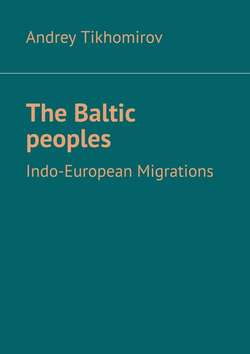The Baltic peoples. Indo-European Migrations

Реклама. ООО «ЛитРес», ИНН: 7719571260.
Оглавление
Andrey Tikhomirov. The Baltic peoples. Indo-European Migrations
The formation of the Baltic community
Culture of the Baltic peoples
Brief grammars of the Latvian and Lithuanian languages
References
Отрывок из книги
The Baltic peoples (Baltic, Baltic) begin to form approximately at the end of the 1st millennium BC, after falling away from the Slavic-Baltic community, before that they were part of the ancient Indo-Europeans who formed within the Great Steppe – from the Southern Urals to the Black Sea. Most likely, the word “Baltic, Baltic” comes from the word “white” – in Latvian balts, in Lithuanian balta. As a scientific term, it was proposed in 1845 by the German linguist Georg Nesselmann, a professor at the University of Königsberg, instead of the term Leto-Lithuanians.
In ancient times, colors meant not only color, but also abstract concepts. And now the expressions “red maiden”, “red square” mean “beautiful girl”, “beautiful square”. Of course, there are explanations of colors in the name of peoples by the color of clothes, the color of the hair or eyes of people. For example, the name of Belarusians (from “White Russia”) when compared with the term “Black Russia”, which in the 13th century. designated part of the territory of Western Belarus, previously captured by the Lithuanian princes, means “free” Russia. The concept of “white”, that is, “light” (holy, in Serbian – “light” – holy, light; in Bulgarian – “holy” – the world, the universe; Saints or Svetovit – the god of the ancient Slavs) forms the concept of “free” from the darkness. The concept of “black” in antiquity meant a state of dependence, oppression, the opposite of the concept of “white”. It is possible that the name “White Russia” consolidated in the 13th century. beyond those parts of modern Belarus that were not conquered by the Mongol-Tatars and were not under the rule of Lithuanian princes. Compare. Black people – in Russian sources of the 14—17th centuries. the term by which the black-sown peasants were designated; black people were also called the entire population of the posad, who paid state taxes, unlike the “White people” who, although they lived in the posad, depended on secular and spiritual feudal lords and did not pay taxes to the state. Black lands is a term in Russian sources of the 14—17th centuries, which denoted lands that were the property of the feudal state and were in use by the peasant and township communities. Black lands are opposed to the “white” land ownership of secular and spiritual feudal lords, who possessed tax and judicial immunity privileges.
.....
In the first centuries of our era, the picture is completely changing. Particularly fast is the development of the tribes of Southern Latvia and Lithuania, drawn into trade with the Roman Empire and the Slavs, who lived along the banks of the Dnieper and the Vistula. Roman merchants traveled through their territory, buying up Baltic amber, which was in great demand in Italy and the provinces. Daugava connected the Baltic states with the Slavs of the Dnieper. In her pool are found Roman metal and jewelry, Roman coins, enamelled items from the Middle Dnieper. At the same time, the import of iron is increasing, and at the same time the processing of local iron – bog ores. Iron products displace bone and stone. Specialist smiths appear. In the grave of a blacksmith found his tools – pincers, hammer, chisel. For the processing of wood, an iron bracket was already used.
Improvement of production tools allowed the development of agriculture, which is becoming the leading branch of the economy. Sickles, hoes, knives, and then braids appear in the burials of the first centuries of our era. By the beginning of our era, wooden plow was introduced into use. Agriculture is becoming arable, obviously, the draft force of cattle is beginning to be applied. Under arable land, forests are cleared. The cultures of rye, oats, barley, flax, turnips, and peas are being developed. The reinforced tribal settlements are replaced by settlements of large and then small families, which, thanks to the development of agriculture, have made it possible to settle in larger territories.
.....